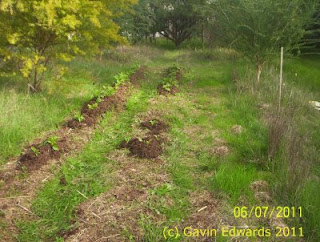
Today I was working in the AP(Apri-plum) Orchard. Its a small orchard we have put in in the last few years. It has some apples, plums, apricots and peaches with herbs under (some of) the trees and vegetables in-between rows. Its been very cold the last few days and I've been thinking the early potatoes are probably going to get frosted, so I thought I'd try hilling them with manure to see if the heat released from its rotting will keep off some of the frost. I've been inspired by what I've read in some old English books about French intensive gardening methods. It's a bit of an experiment so we'll see what happens.
New windbreak trees coming up - mostly tagasaste and early black wattle - fast growing and good chicken food. The
tagasaste also is good goat,sheep and rabbit food, stops some of the heat blast which kills people from a fire, and we burn it as firewood when its dead (its not the best firewood but its not that bad either - good for cooking).
The
early black wattle is extremely fast growing (doubled vegetable production in parts of Indonesia when alley cropped), seeds are good chook food, is a fire retardant (in fact the only tree to have survived a fire near town a few years ago) and makes good firewood when its dead. We are now totally self-sufficient in firewood because of this tree - I started planting them from out of the roadsides about 14 years ago. The local government sees it as a weed. Its only really a problem in degraded verges. Pull them out if you don't like them in the bush and plant them back on small farms where they can do some good!
Windbreak for the AP orchard (and a bit of garlic we weeded a few days ago).